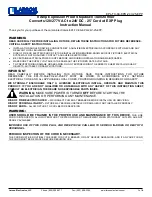
Page 15
HUGO SACHS ELEKTRONIK - HARVARD
A P P A R A T U S
GmbH D-79232 March-Hugstetten Germany
HSE PLUGSYS
®
TAM-A Type 705/1 and TAM-D Type 705/2
This method is possible only when the transducer calibration has been made as an exact
voltage of e.g. 5V/100mmHg. Bring the TAM module in operating mode CAL and connect
a voltmeter to the BNC signal output. Using the CAL adjustment the output voltage is now adjusted to 5
Volt. The output voltage in the CAL position then corresponds to the required CAL value of e.g. 100
mmHg.
Method 2: Adjustment using a voltmeter on the BNC output
In order to remind the simulated calibration value e.g. 100mmHg please write the value with a soft pencil
on the appropriate marker fields on the front panel of the TAM. Any existing writing can readily be removed
using a soft rubber.
R
6.1.3 Transducer calibration on a TAM-D with a digital voltmeter or a DAQ system
The transducer calibration on the TAM-D follows essentially the same procedure as that of
TAM-A. Here additionally the value you measure is displayed as a number in units (e.g. 100mmHg).
Easiest way here is to use a digital voltmeter on the BNC output socket or your data acquisition
system (DAQ) for calibration. (Your DAQ system should show the applied voltage)
Brief description in short form (example with a pressure transducer):
Wished range 200mmHg: which means 200mmHg should be equal to 10V at the BNC output.
Adjust Zero with transducer open to air, connect pressure calibrator and attach 100mmHg,
set GAIN so that you get 5V on the analog output. Adjust display so that it displays 100 (100mmHg).
R
With no load on the transducer, carry out an approximate zero adjustment manually with
the trimmers ZERO-COARSE first and then ZERO-FINE. Adjust Zero so that your voltmeter shows al-
most zero.
Detailed description:
R
Start the AUTOZERO function by pressing the AUTO button in MEASURE MODE until the LED ZERO
goes on, for precise zeroing. The LED ZERO must automatically go off after a few seconds and not be
flashing at the end of the adjustment (no error, zero adjustment OK!).
R
Using a pressure calibrator, apply the calibration reference e.g. 100mmHg to the transducer without alter-
ing the position of the transducer (zero error).
In the case of the example, an output voltage of ±10 Volt has to be set for a range of
± 2 0 0 m m H g .
Now take the litle red screwdriver which was delivered with the system and adjust on the
GAIN 20-100% trimmer the gain so that you get e.g. 5V on your Voltmeter or DAQ
system. Don´t look to the digital display on the TAM-D, it is not set at this point. The adjustment should be
made in conjunction with the recording device (recorder, data acquisition system, oscilloscope)
The larger the applied calibration reference, the more accurate the adjust-
ment which can be made. The ideal situation is when the applied reference
equals the measuring range.
Tip
R
/
S o r r y
In case the amplifier deflection is smaller than expected, the internal gain has
to be suitably increased (jumper J2). The procedure for transducer calibration as described so
far must then be repeated.
The final step should be to check the zero again. The calibration reference load on the trans-
ducer is removed. The signal output of the TAM must then again be exactly zero. If this is not
the case, it is probable that application of the calibration reference load has shifted the trans-
ducer zero. A possible cause is a change in the position of the transducer, pulling on the
connecting cable etc. In order to achieve maximum accuracy it is necessary to repeat the
above adjustment procedure.
Important











































